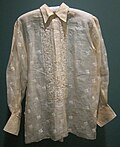 | abacá are thought to have originated from the eastern Philippines, where there is significant rainfall throughout the year. Wild varieties of abacá can... 37 KB (3,839 words) - 22:04, 19 April 2024 |
 | Abaca slippers are made from dried abacá plants and leaves, as well as sometimes from dried pineapple plant leaves. Abaca slippers may be found in the... 841 bytes (66 words) - 20:04, 26 January 2023 |
Abaca bunchy top virus (ABTV) is a pathogenic plant virus of the family Nanoviridae. ABTV has been isolated from both abacá (Musa textilis) and banana... 3 KB (274 words) - 22:40, 26 November 2022 |
significant pathogen of the abaca, along with the Abaca bunchy top virus. Banana bract mosaic virus also infects the abaca, but it is unknown whether the... 2 KB (162 words) - 06:00, 26 January 2023 |
 | of files. The paper was traditionally produced with manila fibers from abacá leaves, a.k.a. manila hemp. This material was named after Manila, capital... 6 KB (625 words) - 13:56, 8 March 2024 |
The Abaca Festival or formally known as Catanduanes Abaka Festival is a festival held each year in Virac, Catanduanes, Philippines. The celebration happens... 3 KB (304 words) - 19:37, 18 April 2024 |
 | It is traditionally made with sheer textiles (nipis) woven from piña or abacá; although in modern times, cheaper materials like organza silk, ramie or... 36 KB (4,083 words) - 10:00, 26 March 2024 |
(coir, ramie, sisal, cotton, flax, hemp, jute, kapok, kenaf, moss, linen, abacá, etc.) Animal fiber (wool, silk, alpaca, camel, angora, cashmere, mohair... 2 KB (164 words) - 16:41, 16 November 2023 |
 | manila hemp (a.k.a. abacá leaves), which was named after Manila, the capital of the Philippines. Beginning in the 1840s, recycled abacá rope fibers were... 10 KB (984 words) - 16:08, 25 March 2024 |

